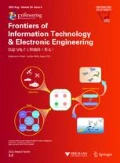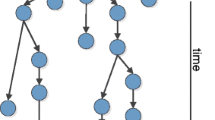Abstract
Message forwarding (e.g., retweeting on Twitter.com) is one of the most popular functions in many existing microblogs, and a large number of users participate in the propagation of information, for any given messages. While this large number can generate notable diversity and not all users have the same ability to diffuse the messages, this also makes it challenging to find the true users with higher spreadability, those generally rated as interesting and authoritative to diffuse the messages. In this paper, a novel method called SpreadRank is proposed to measure the spreadability of users in microblogs, considering both the time interval of retweets and the location of users in information cascades. Experiments were conducted on a real dataset from Twitter containing about 0.26 million users and 10 million tweets, and the results showed that our method is consistently better than the PageRank method with the network of retweets and the method of retweetNum which measures the spreadability according to the number of retweets. Moreover, we find that a user with more tweets or followers does not always have stronger spreadability in microblogs.
Similar content being viewed by others
References
Bakshy, E., Hofman, J.M., Mason, W.A., Watts, D.J., 2011. Everyone’s an Influencer: Quantifying Influence on Twitter. Proc. 4th ACM Int. Conf. on Web Search and Data Mining, p.65–74. [doi:10.1145/1935826.1935845]
Berberich, K., Vazirgiannis, M., Weikum, G., 2004. T-Rank: Time-Aware Authority Ranking. Proc. Algorithms and Models for the Web-Graph: 3rd Int. Workshop, p.131–141. [doi:10.1007/978-3-540-30216-2_11]
Boldi, P., Santini, M., Vigna, S., 2005. PageRank as a Function of the Damping Factor. Proc. 14th Int. Conf. on World Wide Web, p.557–566. [doi:10.1145/1060745.1060827]
Cha, M., Haddadi, H., Benevenuto, F., Gummadi, K.P., 2010. Measuring User Influence in Twitter: the Million Follower Fallacy. Proc. 4th Int. AAAI Conf. on Weblogs and Social Media, p.10–17.
Ding, Z., Jia, Y., Zhou, B., Han, Y., 2013. Mining topical influencers based on the multi-relational network in micro-blogging sites. China Commun., 10(1):93–104. [doi:10.1109/CC.2013.6457533]
Kwak, H., Lee, C., Park, H., Moon, S., 2010. What Is Twitter, a Social Network or a News Media? Proc. 19th Int. Conf. on World Wide Web, p.591–600. [doi:10.1145/1772690.1772751]
Lee, C., Kwak, H., Park, H., Moon, S., 2010. Finding Influentials Based on the Temporal Order of Information Adoption in Twitter. Proc. 19th Int. Conf. on World Wide Web, p.1137–1138. [doi:10.1145/1772690.1772842]
Letierce, J., Passant, A., Breslin, J.G., 2010. Understanding How Twitter Is Used to Spread Scientific Messages. Proc. Web Science Conf., p.91–100.
Liu, Y., Gao, B., Liu, T., Zhang, Y., Ma, Z., He, S., Li, H., 2008. BrowseRank: Letting Web Users Vote for Page Importance. Proc. 31st Annual Int. ACM SIGIR Conf. on Research and Development in Information Retrieval, p.451–458. [doi:10.1145/1390334.1390412]
Macskassy, S.A., Michelson, M., 2011. Why Do People Retweet? Anti-homophily Wins the Day! Proc. 5th Int. AAAI Conf. on Weblogs and Social Media, p.209–216.
Myers, S., Zhu, C., Leskovec, J., 2012. Information Diffusion and External Influence in Networks. Proc. 18th ACM SIGKDD Int. Conf. on Knowledge Discovery and Data Mining, p.33–41. [doi:10.1145/2339530.2339540]
Pal, A., Counts, S., 2011. Identifying Topical Authorities in Microblogs. Proc. 4th ACM Int. Conf. on Web Search and Data Mining, p.45–54. [doi:10.1145/1935826.1935843]
Romero, D.M., Galuba, W., Asur, S., Huberman, B.A., 2011a. Influence and Passivity in Social Media. Proc. 20th Int. Conf. on World Wide Web, p.113–114. [doi:10.1145/1963192.1963250]
Romero, D.M., Meeder, B., Kleinberg, J., 2011b. Differences in the Mechanics of Information Diffusion across Topics: Idioms, Political Hashtags, and Complex Contagion on Twitter. Proc. 20th Int. Conf. on World Wide Web, p.695–704. [doi:10.1145/1963405.1963503]
Sadikov, E., Medina, M., Leskovec, J., Garcia-Molina, H., 2011. Correcting for Missing Data in Information Cascades. Proc. 4th ACM Int. Conf. on Web Search and Data Mining, p.55–64. [doi:10.1145/1935826.1935844]
Tsur, O., Rappoport, A., 2012. What’s in a Hashtag? Content Based Prediction of the Spread of Ideas in Microblogging Communities. Proc. 5th ACM Int. Conf. on Web Search and Data Mining, p.643–652. [doi:10.1145/2124295.2124320]
Tunkelang, D., 2009. A Twitter Analog to PageRank. Available from http://thenoisychannel.com/2009/01/13/atwitteranalog-to-pagerank/
ver Steeg, G., Galstyan, A., 2012. Information Transfer in Social Media. Proc. 21st Int. Conf. on World Wide Web, p.509–518. [doi:10.1145/2187836.2187906]
Weng, J., Lim, E.P., Jiang, J., He, Q., 2010. TwitterRank: Finding Topic-Sensitive Influential Twitters. Proc. 3rd ACM Int. Conf. on Web Search and Data Mining, p.261–270. [doi:10.1145/1718487.1718520]
Wu, S., Hofman, J.M., Mason, W.A., Watts, D.J., 2011. Who SaysWhat to Whom on Twitter. Proc. 20th Int. Conf. on World Wide Web, p.705–714. [doi:10.1145/1963405.1963504]
Yang, J., Counts, S., 2010. Predicting the Speed, Scale, and Range of Information Diffusion in Twitter. Proc. 4th Int. AAAI Conf. on Weblogs and Social Media, p.355–358.
Yang, J., Leskovec, J., 2010. Modeling Information Diffusion in Implicit Networks. Proc. 10th IEEE Int. Conf. on Data Mining, p.599–608. [doi:10.1109/ICDM.2010.22]
Yang, J., Leskovec, J., 2011. Patterns of Temporal Variation in Online Media. Proc. 4th ACM Int. Conf. on Web Search and Data Mining, p.177–186. [doi:10.1145/1935826.1935863]
Ye, S., Wu, F., 2010. Measuring message propagation and social influence on Twitter.com. LNCS, 6430:216–231. [doi:10.1007/978-3-642-16567-2_16]
Yu, P.S., Li, X., Liu, B., 2005. Adding the Temporal Dimension to Search — a Case Study in Publication Search. Proc. IEEE/WIC/ACM Int. Conf. on Web Intelligence, p.543–549. [doi:10.1109/WI.2005.21]
Zaman, T.R., Herbrich, R., Gael, J., Stern, D., 2010. Predicting Information Spreading in Twitter. Proc. Workshop on Computational Social Science and the Wisdom of Crowds, p.20–29.
Author information
Authors and Affiliations
Corresponding author
Additional information
Project supported by the National Natural Science Foundation of China (Nos. 60933005 and 91124002), the National High-Tech R&D Program (863) of China (Nos. 012505, 2011AA010702, 2012AA01A401, and 2012AA01A402), the 242 Information Security Program (No. 2011A010), and the National Science and Technology Support Program (Nos. 2012BAH38B04 and 2012BAH38B06), China
Rights and permissions
About this article
Cite this article
Ding, Zy., Jia, Y., Zhou, B. et al. Measuring the spreadability of users in microblogs. J. Zhejiang Univ. - Sci. C 14, 701–710 (2013). https://doi.org/10.1631/jzus.CIIP1302
Received:
Accepted:
Published:
Issue Date:
DOI: https://doi.org/10.1631/jzus.CIIP1302




